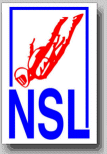
National
Skydiving
League
226 Pecan Street
Deland FL 32724
tel: (386) 801-0804
© 2003 - 2025
All Rights Reserved


226 Pecan Street
Deland FL 32724
tel: (386) 801-0804
© 2003 - 2025
All Rights Reserved

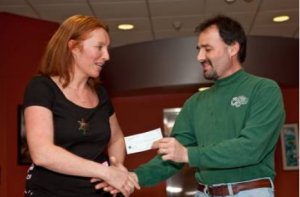
Money raised by Jump for the Cause goes for Breast cancer research and the City of Hope hospital. With the help of Jump for the Cause participants Karen Wood and Maxine Tate this year’s meet was a tremendous success. With the contributions by Carolina Skydiving League, Paraclete-XP and all of the jumpers and visitors, the Jump for the Cause raised $3445. Tate said "this is absolutely fantastic; we sold an awful lot of raffle tickets in addition to the money from the Carolina Skydiving League". During the meet Jump for the Cause sold T-shirts, hats, and raffle tickets for tunnel time with coaching.
In the past, the tunnel meet was just a 4-way RW competition. This year the league added 2-way VRW to the competition. Twenty eight teams competed in the tunnel meet. There were twenty-two teams in the 4-way RW competition in three classes, Rookie, Intermediate, and Open. There were six teams competing in the 2-way VRW in two classes Novice and Open.
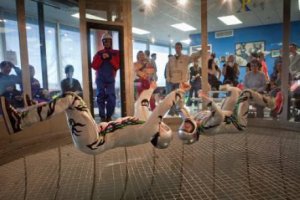
1. How to safely fly competitive 4-way in the tunnel and avoid tunnel funnels
2. Review of basic RW skills
"Tunnel funnels can be awfully dangerous" said Winkelstein. The coaches for the tunnel camp included Brian Krauss of the Golden Knights, Bruce Travis from Skydive Carolina, Joey Freeman formerly of Carolina ICE, and Chris Halsan and Todd Porter of Team Apocalypse. Each coach would work with 2-3 competitors. The camp started with an hour of classroom work. The classroom work included basic entry and exit procedures in the tunnel; basic RW skills, grip discipline, cross referencing, light grips, presentation of grips, levels, and staying in the center of the tunnel. The coaches then worked on a set of random dirt dives with each group. Tunnel camp competitors would each spend 7-10 minutes, in the tunnel with their group, flying the random points practiced during the dirt dive.
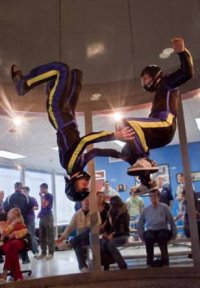
Rounds 3 through 6 inclusive, for the Novice class, consisted of a 4 or 5 points dive of head-up sit-fly formations of randoms and blocks. Rounds 3 through 6 for the Open class consisted of 5 or 6 points of head-up/head-down, head-down/head-down, or sit-fly formations of randoms and blocks. For rounds 3 through 6, both Novice and Open would enter the tunnel and make a 2-way sit-fly consisting of a single hand-to-hand grip. As soon as this grip was broken, the 35-seconds clock would start. Judging for rounds 3 through 6 was done from the booth mounted camera. This provided a side view of the competitors. Because there were only six teams competing in the 2-way VRW, the competition consisted of all six teams in the tunnel for a full hour. "If we had gotten just a few more teams, we could have broken it up, so teams would do only three rounds per session and then have a break. As it was, the teams had to dirt dive all six rounds prior to entering the tunnel" said Winkelstein. Judging for the 2-way VRW was Chris Talbert and Selwyn Facey. 2-way VRW was new to both the judges and the competitors, so it took a little longer to finish the judging then normal and some of the teams had a lot of busts.
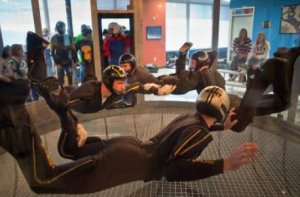
The rules for tunnel 4-way competition call for a 90 second rotation. Teams enter the tunnel make a star (M). Once the star is broken, the clock starts. 35 seconds later, time is over. Just like in 2-way RW if the first point was an M, then teams had to show full separation before regripping. The tunnel mounted overhead camera captured all of the video for all of the 4-way competition (Open, Intermediate and Rookie). As soon as a tunnel session ended, the video was stored to a harddrive. Judges Chris Talbert and Brian Krauss timed and scored competition with only a 20 minute time between completing the rounds and completing the scoring.
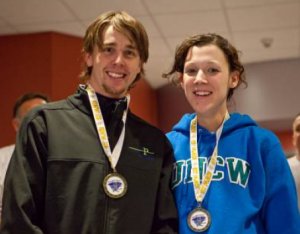
During the annual meeting, Winkelstein announced the finances from the 2008 Skydiving season. The Carolina Skydiving League held 5 meets during the 2008 season and raised $900 for charity. $600 was donated in 2008 to the Wounded Warrior Foundation in the name of the Army Golden Knights who have helped the league by coaching teams and judging the meets. $300 was donated in 2008 to Jump for the Cause.
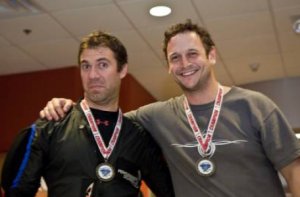
This year the intermediate division used the NSL A Class draw which includes some but not all of the blocks. A large percentage of the intermediate teams do not feel comfortable doing vertical block transitions in the tunnel. "Next year if the tunnel meet gets as high a turnout in the intermediate division, as we did this year, we will have 4 classes instead of three and introduce the USPA Intermediate draw as an event", said Winkelstein.
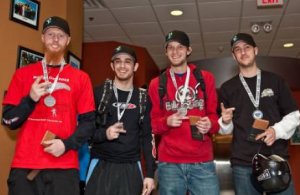
While team "Which end up" came in last place in the intermediate division, team members Chris and Mary Wagner flew all the points of all of the formations upside down. After the first round in the tunnel the crowd watching gave the team a standing ovation. Mary Wagner said "some of the points that we did not expect to be difficult such as the Murphy Flake (C) were pretty challenging".
Coming in first in the Rookie division was team Space Dockers with a 6-round total score of 98. Coming in first in the Intermediate division with a 6-round total score of 100 was The Terror Within.
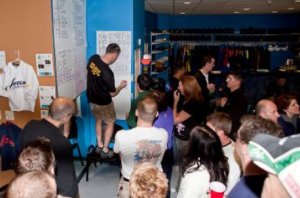
Following the awards, the Carolina Skydiving League presented a check for $1460 to Maxine Tate and Karen Wood of Jump for the Cause. It was about 11:30pm by the time the meet was over. 28 teams had competed in 6 rounds of competition each, and $3445 had been donated to a worthy cause. Next year the league hopes to have an even bigger event.